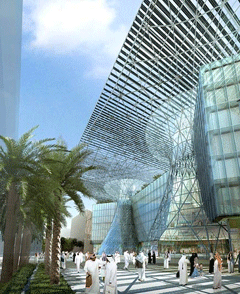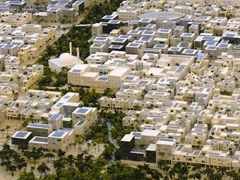Carbon Free City in an Oil Oasis
Air Date: Week of May 30, 2008

Inside the futuristic city. (Courtesy of the Masdar Initiative)
The United Arab Emirates is building a city that designers say will be carbon-neutral and waste-free. Host Bruce Gellerman talks with Sultan Ahmed Al Jaber, the CEO of the Masdar Project, about how a community powered by renewable energy is emerging on the coast of one of the world's major oil producers.
Transcript
GELLERMAN: The United Arab Emirates is very good at defying nature. In oil-rich Abu Dhabi, the capital of U.A.E., temperatures can sizzle to a sweltering 104 degrees Fahrenheit, but you can ski on snow year round – indoors. And in Dubai, they’re building artificial islands. But the U.A.E.’s most ambitious project is designed to work with nature.
[PROMOTIONAL VIDEO VOICEOVER: “Imagine, imagine a place where the challenge of living in an extreme climate is overcome at no cost to the environment. Imagine a place of the future with all of the benefits of twenty-first century living, yet none of the stresses of out-dated twentieth century cities.”]
GELLERMAN: Imagine a two point three square mile planned community with 40,000 inhabitants that produces zero carbon emissions and zero waste.
[PROMOTIONAL VIDEO VOICEOVER: “Imagine Masdar!”]
GELLERMAN: The first phase of Masdar City is set to open in 2010. Dr. Sultan Ahmed Al Jaber is CEO of the project.
AL JABER: Masdar means the source. What we're doing is that we're providing the new source of energy.

Caption: An illustration of what the carbon-free Masdar City would look like. (Courtesy of the Masdar Initiative)
AL JABER: We believe it's a logical step. It's clear that Abu Dhabi has been a global player in the energy sector. What we know is in order for us to keep up with the energy demands around the world and maintain the growth that's happening around the world, we will need to come up with new energy sources. Hydrocarbons will be one of those sources, but we need to come up with new, different, clean solutions that will have no impact on our environment.
GELLERMAN: I was looking online – you have a video of the plan for the city:
[POMOTIONAL VIDEO VOICEOVER: “Organically based systems combined with solar and wind collectors balance carbon emissions and reduce the inhabitants' carbon footprint.”]
GELLERMAN: It’s supposed to be carbon neutral –
AL JABER: Yeah.
GELLERMAN: - and energy positive.
AL JABER: Right.
GELLERMAN: The city’s actually going to produce more energy than it uses.
AL JABER: We’re raising the bar very high. We’re trying to make a statement. We’re trying to make the city become a model of sustainable living, and our ultimate goal here is to have the city replicated and transferred elsewhere around the world. We’re targeting for the whole city to have a neutral balance of CO2, as well as zero waste and for the whole city to be fully powered by renewable energy.

Caption – Inside the futuristic city.
(Courtesy of the Masdar Initiative)
AL JABER: Mainly solar: solar thermal and solar photovoltaics. We’re also going to be producing power from the wind. But what you need to know is that if the city was to be built in the conventional way that cities are being built today, the city would require a minimum of 850 megawatts to power up the whole city. But because of the master plans we put together and because of the energy efficiency measures that we are putting in place, we were able to reduce the energy requirements for the whole city from 850 to 220 megawatts.
GELLERMAN: Wow!
AL JABER: So we're talking about –
GELLERMAN: Seventy....
AL JABER: …seventy, seventy-five percent reduction in energy requirements.
GELLERMAN: So you'll be using very advanced technologies and very modern designs?
AL JABER: Definitely.
GELLERMAN: You're going to have cars?
AL JABER: No cars are allowed within the city. The city is being built on a podium – on a platform. All the infrastructure and the transportation infrastructure will be built underneath the podium. There will be a light rail that will be connecting the Masdar City to the airport and to the downtown Abu Dhabi. There will also be personalized electric vehicles that can be driven within the city.
GELLERMAN: Personal...?
AL JABER: Rapid transport
GELLERMAN: Little electric cars.
AL JABER: Yes.
[POMOTIONAL VIDEO VOICEOVER: “Enjoying your morning coffee on a rooftop garden in the calm of a car-free environment, and getting to work in minutes by your personal rapid transport pod. This PRT network provides door-to-door comfortable travel, whatever your destination.”]
GELLERMAN: In the construction of this city, you're going to be using conventional earthmovers and machinery. They're gonna produce carbon dioxide.
AL JABER: We really would like to practice what we preach from day one, but the technology does not permit and allow us to do so from day one. We will always do our best to minimize our carbon footprint from day one. Now, in the construction phase, we need power. This power is not going to be brought from the national grid. We are building our own ten-megawatt photovoltaic power plant, which will power the construction phase. And if there is any carbon that is being produced, we will always make sure that this carbon is being offset.
GELLERMAN: And how much is all this going to cost?
AL JABER: The total development cost for the whole city is 22 billion U.S. dollars.
GELLERMAN: Twenty-two billion?
AL JABER: Yes. Over eight years, and seven phases.
GELLERMAN: Well, so it'll be carbon neutral and energy positive – is it gonna be financially viable?
AL JABER: Yes, it will be financially viable simply because of the new financing mechanisms, such are carbon finance. This city was to be built in a conventional way – how much carbon would this city produce? And by us doing it this way, how much carbon are we actually saving? With that you can actually generate carbon credits that you can trade in the market. And if we are able to do that in many other cities, we will see a great impact on our environment by reducing our carbon emissions, and we'll see a great impact on our energy supplies.
GELLERMAN: Well Dr. Al Jaber, thank you so very much for coming in.
AL JABER: Thank you, thank you.
GELLERMAN: Dr. Sultan Ahmed Al Jaber is CEO of the Masdar City initiative.
Living on Earth wants to hear from you!
Living on Earth
62 Calef Highway, Suite 212
Lee, NH 03861
Telephone: 617-287-4121
E-mail: comments@loe.org
Newsletter [Click here]
Donate to Living on Earth!
Living on Earth is an independent media program and relies entirely on contributions from listeners and institutions supporting public service. Please donate now to preserve an independent environmental voice.
NewsletterLiving on Earth offers a weekly delivery of the show's rundown to your mailbox. Sign up for our newsletter today!
 Sailors For The Sea: Be the change you want to sea.
Sailors For The Sea: Be the change you want to sea.
 The Grantham Foundation for the Protection of the Environment: Committed to protecting and improving the health of the global environment.
The Grantham Foundation for the Protection of the Environment: Committed to protecting and improving the health of the global environment.
 Contribute to Living on Earth and receive, as our gift to you, an archival print of one of Mark Seth Lender's extraordinary wildlife photographs. Follow the link to see Mark's current collection of photographs.
Contribute to Living on Earth and receive, as our gift to you, an archival print of one of Mark Seth Lender's extraordinary wildlife photographs. Follow the link to see Mark's current collection of photographs.
 Buy a signed copy of Mark Seth Lender's book Smeagull the Seagull & support Living on Earth
Buy a signed copy of Mark Seth Lender's book Smeagull the Seagull & support Living on Earth

